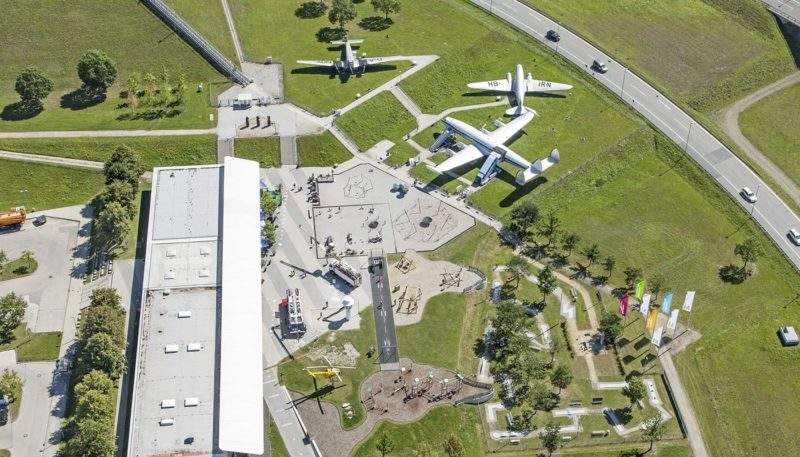
At the heart of Bavaria in Germany, Munich Airport has seen record-breaking growth over the past three years. In 2017, it ranked sixth among Europe’s hub airports and was among the top 20 airports worldwide, carrying 44.6 million passengers over 405,505 flights.
Today it serves 74 countries and 266 destinations, but its sights are set even further: the airport is currently in the early stages of branching out into building a bona fide aerotropolis.
Dubbed LabCampus, the new project aims to build a business and leisure district in and around the airport, which would become a key meeting point for leading experts, start-ups, global players, creative minds and investors. This interdisciplinary ideas centre will be located in the northeast area of the airport and will aim to pave the way for the targeted development and testing of new technologies.
“No other airport has ever created a world of ideas of this kind,” said Munich Airport CEO Dr Michael Kerkloh at the company’s annual press conference in April.
Preparatory work is already underway for the first quadrant, with 120,000m2 of space reserved for new office buildings and a new Airport Academy, which is currently situated outside the airport. The first buildings will be ready for use in 2020 and the airport has set aside around €400m for this first quadrant alone.
In April, Dr Marc Wagener joined LabCampus GmbH, the newly established subsidiary of Munich Airport, with the mission of building, promoting and driving a future-oriented, cross-industry campus for innovators. Here, he explains why Munich Airport is keen to diversify its activity beyond its role as a transit hub.
Eva Grey: Where did the idea behind LabCampus come from?
Dr Marc Wagener: If we talk about LabCampus, we talk about innovation.
If you look at how innovation works, you’ll see that over the past 20 to 30 years, there has been a shift in how innovation is being done. Some 30 years ago, when I started my career, classic innovation was goal-driven; today, there are fewer and fewer areas where this traditional approach is working. The innovation world is now much more decentralised and distributed; I call this the ‘democratisation of innovation’.
For us, one important factor in this distributed world is cooperation across industries, across companies of different sizes, along with start-ups, with academia and so on. This is about orchestrating this network of small and distributed innovation we can see in the world. This is basically what LabCampus is about: we want to be the physical place where people and companies come together in a very creative and open environment.
EG: What makes Munich Airport the ideal place for an innovation centre?
MW: From my perspective, the airport is optimally suited for this, because airports are already much more than just a place where people hop on and off a plane. Munich Airport is now a place where people meet, you have entertainment facilities – so airports are already now at this stage where they play a bigger part.
We have about 150,000 passengers coming here every day, which is the optimal test bed for companies where they could get feedback for their new ideas and products.
In its role as curator, the airport will have to construct LabCampus in three different layers.
The first layer is a special architectural concept of how we set up our little city. There’s a big trend in which work and private life are merging together. You can see in Silicon Valley, they are creating campuses for their employees where they can do more than just work, and that is something we want to bring here. We want to have a special environment, a special campus atmosphere, with an architectural design that allows people to work, go out, where they can be creative and where they can stay after work, bring their kids, or do sports. We want to build a smart city that is suited to the latest trends.
On top of that, we would like to offer the companies specific digitalisation services, which enable them to do better innovation. Here in Munich we also have some excellent institutions that provide start-up services.
And lastly, we also want to play a very active role in bringing the companies together here on the campus, but also within the Munich and Bavaria area.
EG: Which companies have already expressed interest in taking part?
MW: Siemens and SAP are already working on projects with us on the campus. We are in discussions with other companies, and we can see there is a high interest in this at an international level.
We also already have a lot of partners [who] come to the table, research organisations including the Fraunhofer Institute, Friedrich Alexander Universität Erlangen-Nürnberg, the Munich University of Applied Sciences and UnternehmerTUM, and the Technical University of Munich, which specialises in entrepreneurship and start-up foundation.
EG: How do you see the airport, and the local community, capitalising on this project?
MW: We have numerous other projects. LabCampus is about diversification and you might have heard that Munich Airport is innovative in many aspects and we’re growing more as an airport city now. We’re still focusing on the third runway, on expanding our terminal facilities, but we’re not concentrating on one project only: this is not an ‘either/or’ plan for us. It’s more about a balanced approach.
We have a certain industry focus on topics like future mobility, logistics and cyber security, but we also want to be open. We are building something up for the next 20 or 30 years so nobody knows what the trends will be then. So we will also be more open in bringing companies from other industries with a more distant link to the airport here, which we perceive as being innovative in general.



